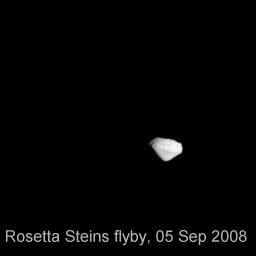Emily Lakdawalla • Jan 11, 2010
Results from the Rosetta Encounter with Asteroid 2867 Steins
Last week in Science magazine appeared the first peer-reviewed article on the results of Rosetta's September 2008 encounter with the smallish main-belt asteroid Steins. This morning I got a chance to sit down and read the article, and I wrote up a summary; basically, the article is a description of what asteroid Steins looks like and what it's likely made of. The single item in the article that'll be cited the most is the basic fact of Steins' dimensions, which are: 6.67 by 5.81 by 4.47 kilometers, equivalent in volume to a sphere with a radius of 2.65 kilometers.
Other notable items:
- The Rosetta images have the south pole up -- it's the south pole that's dominated by an impact crater 2.1 kilometers in diameter.
- There's been much debate on the nature of a line of craters visible along the terminator in the Rosetta images. H. Uwe Keller and his coauthors have decided that this line of craters is real, and they probably are not impact craters, but are instead collapse pits over some subsurface fracture.
- It's almost certainly a rubble pile.
- Steins seems to have a curious rotational history. Its shape strongly suggests that, like many small asteroids, it was "spun up" by solar radiation effects, and the high spin rate caused its rubble to redistribute to a double-cone shape with a strong equatorial bulge. However, it is not presently spinning fast enough for these shape changes to happen.

The Time is Now.
As a Planetary Defender, you’re part of our mission to decrease the risk of Earth being hit by an asteroid or comet.
Donate Today

 Explore Worlds
Explore Worlds Find Life
Find Life Defend Earth
Defend Earth

